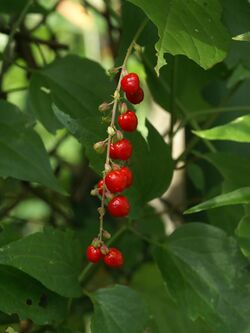Biology:Rivina humilis
| Rivina humilis | |
|---|---|

| |
| Scientific classification Error creating thumbnail: Unable to save thumbnail to destination
| |
| Kingdom: | Plantae |
| Clade: | Tracheophytes |
| Clade: | Angiosperms |
| Clade: | Eudicots |
| Order: | Caryophyllales |
| Family: | Petiveriaceae |
| Genus: | Rivina |
| Species: | R. humilis
|
| Binomial name | |
| Rivina humilis | |
| Synonyms | |
|
Rivina laevis L.[1] | |
Rivina humilis is a species of flowering plant in the family Petiveriaceae. It was formerly placed in the pokeweed family, Phytolaccaceae.[2] It can be found in the southern United States, the Caribbean, Central America, and tropical South America. Common names include pigeonberry,[1] rougeplant,[1] baby peppers,[3] bloodberry,[1] and coralito.[1] The specific epithet means "dwarfish" or "lowly" in Latin, referring to the plant's short stature.[4]
Description
Pigeonberry is an erect, vine-like[5] herb,[3] reaching a height of 0.4–2 m (1.3–6.6 ft).[5] The leaves of this evergreen perennial[6] are up to 15 cm (5.9 in) wide and 9 cm (3.5 in), with a petiole 1–11 cm (0.39–4.33 in) in length. Flowers are on racemes 4–15 cm (1.6–5.9 in) long with a peduncle 1–5 cm (0.39–1.97 in) in length and pedicels 2–8 mm (0.079–0.315 in) long. Sepals are 1.5–3.5 mm (0.059–0.138 in) in length and white or green to pink or purplish.[5] The fruit is a glossy, bright red berry[4] 2.5–5 mm (0.098–0.197 in) in diameter.[5]
Habitat
Rivina humilis can be found in forests, thickets, shell middens, hammocks, roadsides, and disturbed areas at elevations from sea level to 1,700 m (5,600 ft).[5] It requires less than partial sun and is tolerant of full shade. It is also tolerant of salt spray and saline soils.[6]
It is considered invasive in New Caledonia, where it was likely introduced in 1900.[7] It is considered a weed in Queensland, Australia where it has naturalised, and is also naturalised on Cocos Islands, Réunion, Norfolk Island, Fiji, Tonga, French Polynesia, Hawaii, India and the Galapagos Islands.[8]
Uses
Pigeonberry is cultivated as an ornamental in warm regions throughout the world[5] and is valued as a shade-tolerant groundcover.[9] It is also grown as a houseplant[10] and in greenhouses.[5]
The juice made from the berries was used as a dye and ink at one time. The berries contain a pigment known as rivianin or rivinianin,[4] which has the IUPAC name 5-O-β-D-Glucopyranoside, 3-sulfate, CAS number 58115-21-2, and molecular formula C24H26N2O16S.[11] It is very similar to betanin, the pigment found in beets.[4] The fruit also contains the betaxanthin humilixanthin.[12]
The juice of the berries have been tested in male rats and are reported to be safe to consume.[13]
Ecology
R. humilis is a host plant for the caterpillars of Goodson's greenstreak (Cyanophrys goodsoni)[14]
References
- ↑ 1.0 1.1 1.2 1.3 1.4 {{citation | mode = cs1 | title = Rivina humilis | work = Germplasm Resources Information Network (GRIN) | url = | publisher = [[Organization:Agricultural Research ServAgricultural Research Service (ARS), United States Department of Agriculture (USDA) | access-date = 2009-12-09 }}
- ↑ Angiosperm Phylogeny Group (2016). "An update of the Angiosperm Phylogeny Group classification for the orders and families of flowering plants: APG IV". Botanical Journal of the Linnean Society 161 (2): 105–20. doi:10.1111/boj.12385.
- ↑ 3.0 3.1 "Rivina humilis L.". Native Plant Information Network. Lady Bird Johnson Wildflower Center. http://www.wildflower.org/plants/result.php?id_plant=RIHU2.
- ↑ 4.0 4.1 4.2 4.3 Nellis, David W (1997). Poisonous Plants and Animals of Florida and the Caribbean. Pineapple Press Inc. p. 227. ISBN 978-1-56164-111-6. https://books.google.com/books?id=C8xJE2NfQpIC.
- ↑ 5.0 5.1 5.2 5.3 5.4 5.5 5.6 "Rivina humilis Linnaeus, Sp. Pl. 1: 121. 1753". Flora of North America. eFloras.org. http://www.efloras.org/florataxon.aspx?flora_id=1&taxon_id=220011674.
- ↑ 6.0 6.1 "Pigeonberry Rivina humilis". Ornamental for the Texas Gulf Coast. Texas A&M University. http://aggie-horticulture.tamu.edu/ornamentals/coastalplants/rivina.html.
- ↑ Hequet, Vanessa (2009) (in fr). Les espèces exotiques envahissantes de Nouvelle-Calédonie. pp. 17, 47. http://horizon.documentation.ird.fr/exl-doc/pleins_textes/divers12-08/010052239.pdf.
- ↑ "Coral berry | Weed Identification – Brisbane City Council". https://weeds.brisbane.qld.gov.au/weeds/coral-berry-0.
- ↑ Garrett, Howard (1996). Howard Garrett's Plants for Texas. University of Texas Press. p. 140. ISBN 978-0-292-72788-5. https://books.google.com/books?id=sstzZK40xjgC.
- ↑ "Pigeon Berry Latin Name: Rivina humilis". Plant Encyclopedia. PlantCare.com. http://www.plantcare.com/encyclopedia/pigeon-berry-855.aspx. Retrieved 2009-12-09.
- ↑ D. C. Ayres, ed (1994). Dictionary of Natural Products. 7. CRC Press. p. 645. ISBN 978-0-412-46620-5. https://books.google.com/books?id=1W0NUD42fA4C.
- ↑ Humilixanthin a new betaxanthin from Rivina humilis. Dieter Strack, Doris Schmitt, Hans Reznik, Wilhelm Boland, Lutz Grotjahn and Victor Wray, Phytochemistry, 1987, Volume 26, Issue 8, Pages 2285–2287, doi:10.1016/S0031-9422(00)84702-0
- ↑ Food Chem. Toxicol., December 2011, volume 49, issue 12, pages 3154-3157
- ↑ "Goodson's Greenstreak Cyanophrys goodsoni (Clench, 1946)". Butterflies and Moths of North America. http://www.butterfliesandmoths.org/species?l=1512.
External links
- Rivina humilis can also be found in the Philippines from the Int'l Society for Taxonomic Explorations by Isidro A. T. Savillo
Wikidata ☰ Q886492 entry
 |


